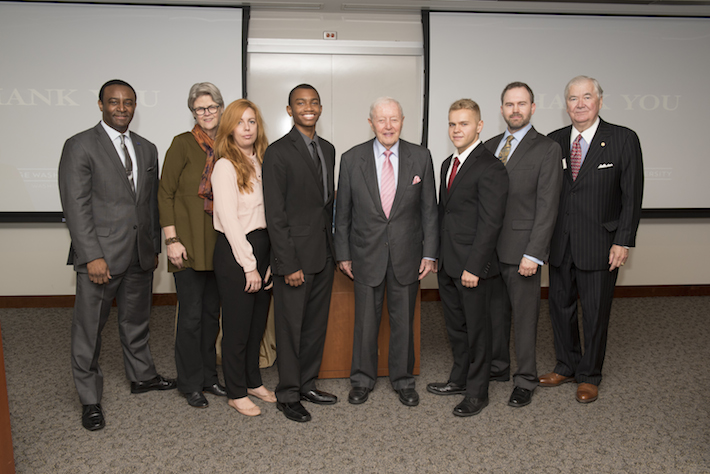When the new George Washington University Museum and The Textile Museum opens in March 2015, its beautifully renovated Woodhull House will be home to Albert H. Small’s unparalleled trove of rare Washington maps, documents and other exceptional artifacts—and already, students and faculty are discovering just how much this historic collection will enrich research at GW.
Mr. Small, a 2009 recipient of the Presidential Humanities Medal, donated the Washingtoniana Collection to GW in 2011. Members of the university community celebrated how the collection has expanded scholarship and inspired cross-disciplinary collaborations across the university on Wednesday at the annual Albert H. Small Symposium, which coincided with Mr. Small’s 89th birthday.
Before donating the collection to GW, Mr. Small considered giving it to the National Museum of American History, the National Archives or the Library of Congress. Ultimately, he chose GW, where scholars could engage with the pieces of history he’d collected.
“Albert’s quest when collecting these items of historic significance wasn’t just to put them on the wall. But a priority he had was to share it with current generations and future generations,” said GW Trustee Robert G. Perry, B.S. ’70.
Mr. Small emphasized how proud he is to have GW build a museum that will showcase his collection. He hopes it will “enable students, teachers, visitors of the museum to learn about the capital of our country and the development of the city of Washington,” he said.
His wish already is coming true. In the museum studies department, Professor Barbara Brennan has used Mr. Small’s gift to create every budding designer’s dream assignment. In her classes, no lessons are simply gleaned from a textbook. Instead, she puts her students to work. Last semester, she co-taught a class with Professor Carl Gudenius and challenged students to design the first Washingtoniana exhibits that will be displayed at the new GW museum.
“It’s always my goal when I teach a class to have students design something that is actually going to be installed,” Dr. Brennan explained.
Nathalie Nelson, a graduate of the exhibition design certificate program, worked on “Seat of Empire: Planning Washington, 1790–1801,” which will open at the new museum in March. The show was curated by Professor of History Tyler Anbinder using historic maps and other images from the Washingtoniana collection. It chronicles the evolution of the city’s urban design. Ms. Nelson met with Mr. Small and interacted firsthand with the exhibit’s objects, an experience she said helped her fully understand the power of the Washingtoniana collection.
Ms. Nelson, who is a foreign-born student, also noted that in addition to boosting her design expertise, working with the Washingtoniana collection better acquainted her to her new home in D.C.
“I had just been here for a brief time, and I didn’t know much about the city I lived in, but thanks to the collection, I learned a lot,” Ms. Nelson said.
That emphasis on Washington scholarship is one of the most significant attributes of the collection for urban historian and Professor of History Christopher Klemek. He thanked Mr. Small for “a whole spirit of excitement descending on the campus right now,” and said the new museum already is promoting conversations about urban studies.
“As a member of the history department, I’m really delighted to tap into the possibilities that abound now, thanks to you,” Dr. Klemek told Mr. Small.
Dr. Klemek explained that he wanted to lead a class where students could contribute research to the broader D.C. community. So last spring, he came up with a plan for his “Washington, D.C.: History, Culture, Politics” course. Rather than collecting papers that would languish in his filing cabinet, Dr. Klemek instructed his students to create DigitalDC, a permanent online exhibition where the general public can learn about specific areas of Foggy Bottom.
Junior Nicholas DiNella and Ryan Jones, a high school student attending GW through the Early College Program, both used the Washingtoniana collection to conduct research for Digital DC. Using the collection’s maps, Mr. Jones discovered that the Watergate Complex between 25th and 27th streets Northwest was once used as an industrial and manufacturing hub during the city’s early years.
Mr. DiNella described how he used primary documents to chronicle the history of Foggy Bottom’s Square 54 area, where Whole Foods is located today. An 1865 stenciling from the Washingtoniana Collection provided some context. It helped him figure out that Square 54 once housed Camp Fry, a temporary military base established during the Civil War.
Columbian College of Arts and Sciences Dean Ben Vinson III provided closing remarks, thanking Mr. Small for giving students the opportunity to lean more about Washington.
“Hopefully, today is a small gift back in return to you for your gift to us. Happy birthday,” Dr. Vinson said.
Albert H. Small receives a gift from GW President Steven Knapp on his 89th birthday.


